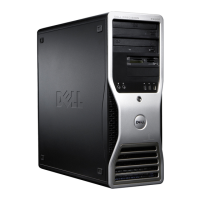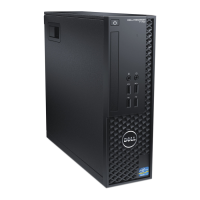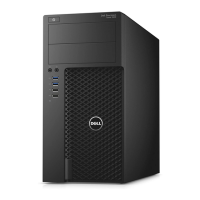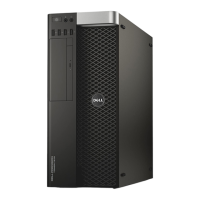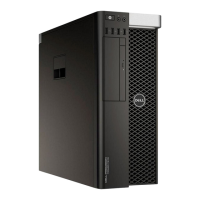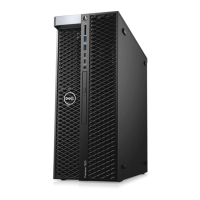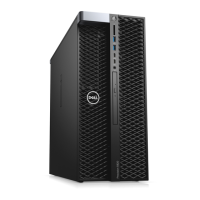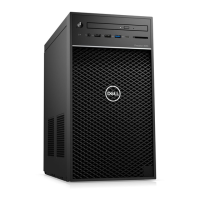Do you have a question about the Dell Precision T3610 and is the answer not in the manual?
Safety guidelines and preparation steps before performing internal computer maintenance.
Procedure for safely shutting down the computer's operating system and power.
Steps to reconnect external devices and cables after component replacement.
Lists essential tools required for component removal and installation procedures.
Diagram and labels identifying key internal components of the T3610 computer.
Step-by-step instructions for removing the PSU from the computer chassis.
Step-by-step instructions for installing the PSU into the computer chassis.
Procedure for safely removing the computer's outer cover.
Procedure for correctly reattaching the computer's outer cover.
Steps to disconnect and remove the PSU card from the system.
Steps to install the PSU card back into its slot.
Procedure for detaching the front bezel from the computer chassis.
Procedure for reattaching the front bezel to the computer chassis.
Steps to disconnect and remove the optical drive from the bay.
Steps to install the optical drive into its bay.
Procedure for disconnecting and removing the hard drive from its bay.
Steps for installing a hard drive into the computer's drive bay.
Procedure to disconnect and remove the internal speaker.
Steps to reconnect and install the internal speaker.
Procedure for installing an optional thermal sensor.
Procedure to remove an optional thermal sensor from the computer.
Steps to disconnect and remove the front I/O panel assembly.
Steps to install the front I/O panel assembly.
Procedure to remove the air tunnel component from the chassis.
Procedure to install the air tunnel component into the chassis.
Steps to remove a memory module from its socket.
Steps to install a memory module into its socket.
Procedure to remove the coin-cell battery from the system board.
Procedure to install the coin-cell battery onto the system board.
Steps to disconnect and remove the system fan assembly.
Steps to install the system fan assembly into the chassis.
Procedure to disconnect and remove the heatsink from the processor.
Steps to install the heatsink onto the system board.
Procedure to remove the heatsink fan from the heatsink assembly.
Procedure to install the heatsink fan into the heatsink assembly.
Steps to safely remove the processor from its socket.
Steps to safely install the processor into its socket.
Procedure to disconnect cables and remove the system board.
Steps to align, secure, and connect the system board.
Diagram showing the locations of various components on the system board.
General guidelines for optimal performance when configuring system memory.
Information on how to lock or unlock the PSU using a screw.
How to bypass boot order and boot directly to a specific device.
Description of keyboard keys used for navigating the System Setup utility.
Details on System Board, Boot Sequence, Boot List Option, and Advanced Boot Options.
How to set and adjust the computer's date and time.
Configuration options for the integrated network controller.
Enabling or disabling hard drive error reporting during system startup.
Options to enable or disable internal USB ports and boot support.
Setting the primary boot video device.
Setting, changing, or deleting the password for the system's internal hard disk drive.
Enabling or disabling the Execute Disable mode for the processor.
Enabling or disabling multi-core support for the processor.
Configuring how the computer responds to AC power loss and recovery.
Setting the time for automatic computer startup.
Speeding up the boot process by bypassing compatibility steps.
Enabling hardware capabilities for Virtual Machine Monitor (VMM).
Displays the service tag of your computer.
Procedure to update the system's BIOS (Basic Input/Output System).
Setting a password required to log on to the system.
Steps to set or change system and setup passwords.
Procedure to delete or change existing system and setup passwords.
Procedure to disable system passwords using the PSWD jumper.
Steps to run the embedded ePSA diagnostics for hardware testing.
Interpreting diagnostic LED patterns for troubleshooting POST issues.
Warning messages that do not stop the computer boot process.
Error messages causing a soft halt, requiring user interaction to continue.
Details on processor type, cache, and core count.
Details on chipset and BIOS chip.
Information on memory module connectors and capacity.
Specifications for discrete video card slots and maximum wattage.
Details on USB port types, speeds, and locations.
Information on drive bay types and capacities for T3610/T5610 and T7610.
Details on the serial port connector.
Details on system power, fan, memory, processor, and PCI Express connectors.
Details on front USB port types and configurations.
Explanation of power button light colors and their meanings.
Details on the coin-cell battery type and voltage.
Specifications for power supply wattage and heat dissipation.
Specifies operating and storage temperature ranges for the computer.
Specifies the maximum relative humidity for operation and storage.
Instructions on how to find contact information for Dell support.
Safety guidelines and preparation steps before performing internal computer maintenance.
Procedure for safely shutting down the computer's operating system and power.
Steps to reconnect external devices and cables after component replacement.
Lists essential tools required for component removal and installation procedures.
Diagram and labels identifying key internal components of the T3610 computer.
Step-by-step instructions for removing the PSU from the computer chassis.
Step-by-step instructions for installing the PSU into the computer chassis.
Procedure for safely removing the computer's outer cover.
Procedure for correctly reattaching the computer's outer cover.
Steps to disconnect and remove the PSU card from the system.
Steps to install the PSU card back into its slot.
Procedure for detaching the front bezel from the computer chassis.
Procedure for reattaching the front bezel to the computer chassis.
Steps to disconnect and remove the optical drive from the bay.
Steps to install the optical drive into its bay.
Procedure for disconnecting and removing the hard drive from its bay.
Steps for installing a hard drive into the computer's drive bay.
Procedure to disconnect and remove the internal speaker.
Steps to reconnect and install the internal speaker.
Procedure for installing an optional thermal sensor.
Procedure to remove an optional thermal sensor from the computer.
Steps to disconnect and remove the front I/O panel assembly.
Steps to install the front I/O panel assembly.
Procedure to remove the air tunnel component from the chassis.
Procedure to install the air tunnel component into the chassis.
Steps to remove a memory module from its socket.
Steps to install a memory module into its socket.
Procedure to remove the coin-cell battery from the system board.
Procedure to install the coin-cell battery onto the system board.
Steps to disconnect and remove the system fan assembly.
Steps to install the system fan assembly into the chassis.
Procedure to disconnect and remove the heatsink from the processor.
Steps to install the heatsink onto the system board.
Procedure to remove the heatsink fan from the heatsink assembly.
Procedure to install the heatsink fan into the heatsink assembly.
Steps to safely remove the processor from its socket.
Steps to safely install the processor into its socket.
Procedure to disconnect cables and remove the system board.
Steps to align, secure, and connect the system board.
Diagram showing the locations of various components on the system board.
General guidelines for optimal performance when configuring system memory.
Information on how to lock or unlock the PSU using a screw.
How to bypass boot order and boot directly to a specific device.
Description of keyboard keys used for navigating the System Setup utility.
Details on System Board, Boot Sequence, Boot List Option, and Advanced Boot Options.
How to set and adjust the computer's date and time.
Configuration options for the integrated network controller.
Enabling or disabling hard drive error reporting during system startup.
Options to enable or disable internal USB ports and boot support.
Setting the primary boot video device.
Setting, changing, or deleting the password for the system's internal hard disk drive.
Enabling or disabling the Execute Disable mode for the processor.
Enabling or disabling multi-core support for the processor.
Configuring how the computer responds to AC power loss and recovery.
Setting the time for automatic computer startup.
Speeding up the boot process by bypassing compatibility steps.
Enabling hardware capabilities for Virtual Machine Monitor (VMM).
Displays the service tag of your computer.
Procedure to update the system's BIOS (Basic Input/Output System).
Setting a password required to log on to the system.
Steps to set or change system and setup passwords.
Procedure to delete or change existing system and setup passwords.
Procedure to disable system passwords using the PSWD jumper.
Steps to run the embedded ePSA diagnostics for hardware testing.
Interpreting diagnostic LED patterns for troubleshooting POST issues.
Warning messages that do not stop the computer boot process.
Error messages causing a soft halt, requiring user interaction to continue.
Details on processor type, cache, and core count.
Details on chipset and BIOS chip.
Information on memory module connectors and capacity.
Specifications for discrete video card slots and maximum wattage.
Details on USB port types, speeds, and locations.
Information on drive bay types and capacities for T3610/T5610 and T7610.
Details on the serial port connector.
Details on system power, fan, memory, processor, and PCI Express connectors.
Details on front USB port types and configurations.
Explanation of power button light colors and their meanings.
Details on the coin-cell battery type and voltage.
Specifications for power supply wattage and heat dissipation.
Specifies operating and storage temperature ranges for the computer.
Specifies the maximum relative humidity for operation and storage.
Instructions on how to find contact information for Dell support.
| Tcase | 70 °C |
|---|---|
| Bus type | QPI |
| FSB Parity | No |
| Processor cache | 10 MB |
| Processor cores | 4 |
| Processor model | E5-1620V2 |
| System bus rate | - GT/s |
| Processor series | Intel Xeon E5-1600 v2 |
| Processor socket | LGA 2011 (Socket R) |
| Processor threads | 8 |
| Processor codename | Ivy Bridge EP |
| Processor frequency | 3.7 GHz |
| Processor cache type | Smart Cache |
| Processor lithography | 22 nm |
| Processor manufacturer | Intel |
| Processor front side bus | - MHz |
| PCI Express slots version | 3.0 |
| Processor boost frequency | 3.9 GHz |
| Processor operating modes | 64-bit |
| ECC supported by processor | Yes |
| PCI Express configurations | x4, x8, x16 |
| Thermal Design Power (TDP) | 130 W |
| Number of processors installed | 1 |
| Maximum number of PCI Express lanes | 40 |
| Memory types supported by processor | DDR3-SDRAM |
| Memory clock speeds supported by processor | 800, 1066, 1333, 1600, 1866 MHz |
| Memory bandwidth supported by processor (max) | 59.7 GB/s |
| Maximum internal memory supported by processor | 256 GB |
| Memory slots | 8x DIMM |
| Internal memory | 16 GB |
| Memory channels | Quad-channel |
| Memory clock speed | 1866 MHz |
| Maximum internal memory | 128 GB |
| Memory layout (slots x size) | 4 x 4 GB |
| HDD size | 3.5 \ |
| HDD speed | 7200 RPM |
| HDD interface | SATA |
| Storage media | HDD |
| Optical drive type | DVD±RW |
| Total storage capacity | 1000 GB |
| Discrete graphics card model | NVIDIA® Quadro® K4000 |
| On-board graphics card model | Not available |
| Discrete graphics card memory | 3072 GB |
| Discrete graphics memory type | GDDR5 |
| Trial software | Microsoft Office |
| Recovery operating system | Windows 8 Pro |
| Operating system installed | Windows 7 Professional |
| PS/2 ports quantity | 2 |
| USB 2.0 ports quantity | 6 |
| VGA (D-Sub) ports quantity | 0 |
| Chassis type | Midi Tower |
| Product color | Black |
| Audio system | Realtek ALC269Q |
| Product type | Workstation |
| Motherboard chipset | Intel® C602 |
| Scalability | 1S |
| Processor ARK ID | 75779 |
| Processor package size | 52.5 x 45.0 mm |
| Supported instruction sets | AVX |
| Intel Secure Key Technology version | 1.00 |
| Intel Identity Protection Technology version | 0.00 |
| Sustainability certificates | ENERGY STAR |
| Depth | 471 mm |
|---|---|
| Width | 172.6 mm |
| Height | 414 mm |
| Weight | - g |

